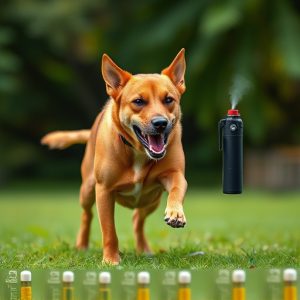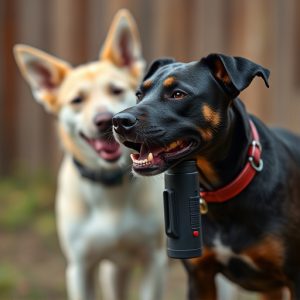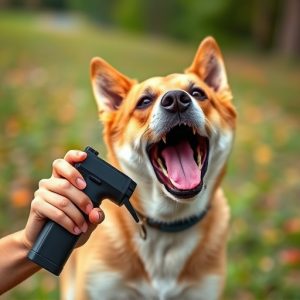Mace Dog Spray Range: Understanding Effective Distance & Emergency Care
TL;DR: Emergency Care for Mace-Exposed AnimalsMace dog spray, a non-lethal defense tool against aggr…….
TL;DR: Emergency Care for Mace-Exposed Animals
Mace dog spray, a non-lethal defense tool against aggressive dogs containing capsaicin, temporarily incapacitates them by irritating sensitive areas. Effective range is crucial for successful incapacitation and is influenced by wind conditions, application angle, and environmental factors. In case of exposure, immediate emergency care is necessary to treat symptoms like panting, tearing, and difficulty breathing. This involves removing the dog from the contaminated area, washing affected parts with warm water, and seeking veterinary assistance, especially for severe cases. Responsible use, storage, and adherence to manufacturer guidelines are key to preventing Mace-related emergencies in animals.
Mace dog spray, a popular non-lethal self-defense tool against aggressive canines, has sparked curiosity. This article delves into its effectiveness, exploring the science behind its composition and how it works. We analyze the critical factors influencing the effective distance of mace dog spray, providing insights for responsible usage. Additionally, we outline emergency care procedures for those exposed to mace dog spray, emphasizing symptoms, treatment, and prevention measures, focusing on the well-being of both victims and animals, with a special emphasis on emergency care for maced animals.
- Understanding Mace Dog Spray: A Closer Look at its Composition and Function
- Effective Distance of Mace Dog Spray: Factors Influencing Range and Accuracy
- Emergency Care After Exposure to Mace Dog Spray: Symptoms, Treatment, and Prevention Measures
Understanding Mace Dog Spray: A Closer Look at its Composition and Function
Mace dog spray, also known as pepper spray designed for animals, is a non-lethal self-defense tool used to deter aggressive dogs. Unlike human pepper sprays, animal-specific mace sprays have unique formulations tailored to quickly incapacitate dogs without causing serious harm. These products typically contain capsaicin, the active ingredient found in chili peppers, which irritates the dog’s eyes, nose, and throat, leading to temporary disorientation and a decrease in aggression.
Understanding the composition is crucial for effective emergency care for maced animals. While pepper spray is designed to be non-lethal, it can still cause discomfort and potential side effects. After exposure, affected dogs may exhibit excessive drooling, teary eyes, coughing, or difficulty breathing. Owners should seek immediate veterinary assistance post-exposure to ensure the animal’s well-being and provide prompt emergency care as needed.
Effective Distance of Mace Dog Spray: Factors Influencing Range and Accuracy
Mace dog spray, a popular non-lethal deterrent, is designed to temporarily incapacitate an aggressive canine. Understanding its effective distance is crucial for both animal owners and emergency care professionals. The range at which this spray can be deployed successfully varies based on several factors. One of the primary influences is the wind; a gentle breeze can carry the spray particles away from the intended target, reducing its effectiveness. Conversely, strong winds might blow the spray back towards the user, posing potential harm.
Another critical factor is the angle and force with which the spray is directed. Aiming directly at the dog’s face and eyes significantly increases the likelihood of a successful incapacitation. Moreover, the can’s nozzle design plays a role; some models are designed for longer-range applications, while others are optimized for accuracy at closer distances. The environment also matters; in densely populated areas or environments with numerous obstructions, the spray’s reach may be shorter due to objects deflecting or interrupting its path. Knowing these influencing factors is essential for effective emergency care involving mace dog spray.
Emergency Care After Exposure to Mace Dog Spray: Symptoms, Treatment, and Prevention Measures
In the event of exposure to Mace dog spray, emergency care is crucial for affected animals. If a dog comes into contact with this irritant, owners or handlers should immediately look for signs and symptoms such as excessive panting, tearing, reddened eyes, and difficulty breathing. These indications suggest respiratory distress and eye irritation, which require prompt action.
Treatment involves removing the dog from the contaminated area, thoroughly washing its face, paws, and any affected areas with warm water to dilute the spray residue. In severe cases, seeking veterinary assistance is vital. Veterinarians may administer oxygen therapy, antihistamines, or other medications to alleviate symptoms. To prevent emergency situations related to Mace dog spray, it’s essential to store and use it responsibly, ensuring proper ventilation during application and adhering to manufacturer guidelines for safe handling.
Understanding the effective distance of mace dog spray is crucial for both users and those who interact with animals. By recognizing the factors influencing its range and accuracy, individuals can ensure safer and more effective usage during emergencies involving aggressive dogs. Moreover, being prepared for potential exposure through proper emergency care measures, including knowing symptoms, treatment options, and preventive strategies, is essential for safeguarding both humans and animals alike. As such, arming yourself with knowledge about mace dog spray and its implications for emergency care can prove to be a game-changer in navigating these challenging situations.


